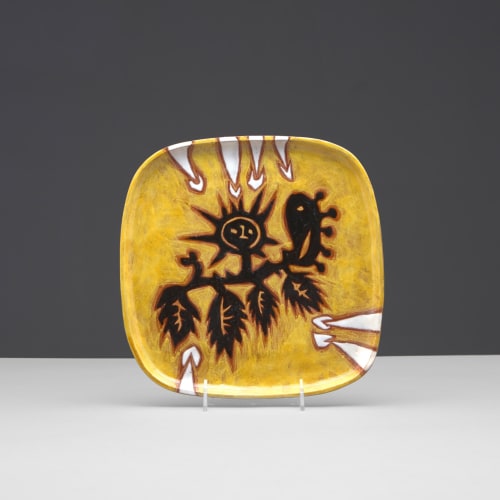Although their unique styles of abstraction differ, Caziel and Lurçat’s works are distinguished by their considered yet energetic treatment of shapes, forms, and colours.
Whitford Fine Art is delighted to present our online Winter Exhibition 2021: CAZIEL x LURÇAT, comprising a selection of works on paper by Polish artist Caziel (1906-1988) and ceramics by French artist Jean Lurçat (1892-1966). Despite differences of generation, style and medium, both Lurçat and Caziel were disciples of the ‘École de Paris’ and both arrived at personal styles of abstraction as optimistic and buoyant as the artistic current which was sweeping through Post-War 1950s Paris.
After graduating from the Warsaw Academy of Fine Art in 1936, Caziel emigrated to Paris in 1937. However, after voluntarily joining the Polish army in France in 1939 at the onset of WWII, the Franco-German armistice of 1940 forced the Polish army to disband and Caziel to relocate to Aix-en-Provence where he stayed until the autumn of 1946. After his return to Paris in 1947, he held his first one-man show at the Galerie Allard that same year and was invited to exhibit at the prestigious ‘Salon de Mai’ alongside the likes of Hans Hartung, Victor Vasarely and, most importantly, Pablo Picasso. Caziel developed a close friendship with the latter, with whom he shared a studio from 1948 to 1951.
This personal acquaintance with Picasso did not have a direct influence on Caziel’s art but did inspire him to study Cubism. By 1948, Caziel had already begun to explore abstract painting and after studying the early Cubist innovations of Braque and Picasso, he began to arrive at his own personal brand of abstraction in the early 1950s. Echoes of the Cubist aesthetic can be seen in his monochromatic works, the compositions of which are a skilful balance of abstract geometric and biomorphic forms. This contrasting yet complimentary combination points to a spontaneity in his abstract works of a more gestural nature, composed of dynamic tangles of interlacing lines at the intersections of which pop pockets of bright primary colours. When taken together, despite their restrained palette, Caziel’s works emit an undeniable vitality.
Whilst Caziel’s career and personal style of abstraction were beginning to gather momentum, Jean Lurçat was already an important and established painter of the ‘École de Paris’. However, he also experimented with a variety of different media, including tapestry and lithography, but it was with ceramics with which he became enamoured late in his career. As if to make up for lost time, he worked tirelessly and fruitfully at the workshop of Firmin Bauby - Mas Sant-Vicens in Perpignan - travelling there at least twice a year, every year, from 1951 until his death in 1966.
Unlike Caziel, Lurçat’s designs are firmly rooted in figurative abstraction, his ceramic design concentrating on flora, fauna and mythological and imagined creatures. These semi-abstract shapes and figures dance, dart and intermingle in a flat pictorial space of rich, concentrated earth tones and contrasting primary colours, overlaid in brilliant glazes. Punctuations of attendant geometric and biomorphic forms further enhance the fluency of Lurçat’s style of figurative abstraction. His designs achieve a sense of movement and painterly spontaneity difficult to achieve in ceramics. Lurçat’s continual, assured exploration of varying motifs and combinations of colours, shapes and forms speak of an artist enthralled by his medium.
Although their unique styles of abstraction differ, Caziel and Lurçat’s works presented here are distinguished by their considered yet energetic treatment of shapes, forms, and colours. When seen and considered together, both ceramics and works on paper are equally laden with the poetry of momentary incidents. These instances of spontaneity are the key feature of both artists’ unique abstract language, perfectly expressing that joy of unfettered artistic creation and expression was brought about by Abstraction and permeated 1950s Paris. The shared exuberance and energy of the art of the upcoming Caziel and the mature Lurçat is a joy to behold.


